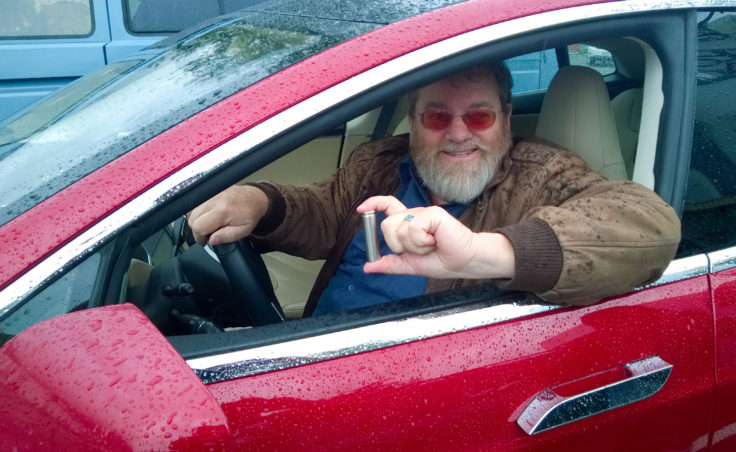Seconds after Guy Hall pulled into a parking lot full of Subarus at KTOO on Monday, five reporters were gawking at his sleek, red Tesla Model S.
Hall is the president of the Sacramento Electric Vehicle Association. He spent 17 days driving from the California-Mexico border to Fairbanks, and now he’s on the return leg.
He’s a retired Hewlett-Packard research and development guy and an electric car evangelist. At home in Sacramento, he has two more modest electric cars: a Nissan Leaf and a Chevy Volt.
But it’s the sporty, high-end Tesla that made the 3,400 mile journey north and has the wow factor.
He puts me behind the wheel and tells me to punch it when we’re on Egan Drive. We get pushed into our seats as the car accelerates, and we both break into giddy laughter.
“I won’t say what the speed is that we saw that go up to, but it was worthy of a ticket-me-red color car,” Hall says.
The laugh is symptomatic of what Hall calls “the Tesla grin.”
There’s no fuel to pump, no engine to rev, no gears to shift, no transmission. Pressing on the accelerator translates into electrons moving at the speed of light to the electric motor driving the rear wheels.
Where you’d expect an engine compartment up front is a second trunk. Hall calls it “the frunk.” Another big difference is at start up. The windshield wiper makes more noise than the drivetrain.
“Almost no sound compared to a gas car,” Hall says.
The battery is a heavy, flat panel that makes up much of the undercarriage. Its shape evenly distributes the weight and the location keeps the center of gravity low; that’s good for handling. The battery is actually made up of a series of more than 7,000 cells, each about the size and shape of a shotgun shell.
Hall says besides spreading the word, his trip was about seeing if an electric vehicle could even make it. His battery has a range of about 265 miles and charging stations are rare.
“But I was able to determine you can do it. There’s sources of electricity everywhere you go,” Hall says.
According to Tesla, a full charge would take more than three days from a standard 110-volt outlet. It takes about nine hours through a less common 240-volt outlet. Beefy appliances like laundry dryers and water heaters use those in the house. Electric car owners get them installed in their garages.
The 240-volt outlet is also a common hookup for RVs. So on the road, Hall charged up at RV parks. He says he even traded rides for some charging time at industrial shops and garages along the way.
“I wanted to set a baseline of how long it takes to get from the Mexican border up to Fairbanks,” Hall says. “And once that’s set, now others can try to beat it. And as someone gets a new record for it, (a) trophy will go on to them and it’ll rotate around.”
Will electric cars catch on in Juneau?
Right now, the only public charging station on Juneau’s isolated road system is at Alaska Electric Light & Power. But more are coming. The Juneau Economic Development Council helped raise $50,000 in grant money to build infrastructure supporting electric vehicles.
[googlemaps https://mapsengine.google.com/map/embed?mid=z4ukvTcI6LL4.k6kbSoHA3Z-U&w=640&h=480]Contributors
The Juneau Economic Development Council secured a $25,000 grant from the Florida-based Funders’ Network for Growth and Livable Communities for electric vehicle infrastructure and education.
It required a $25,000 local match. The local donors are Juneau Hydropower, IBEW, Stanley Ford, AEL&P, The Leighty Foundation and the Juneau Community Foundation’s Blue Heron Fund.
The council’s Zach Wilkinson says five two-outlet electric vehicle chargers are on their way to Juneau thanks to the grant. They’ll be installed at the Eaglecrest Ski Area, downtown parking garage, new Mendenhall Valley library that’s under construction, University of Alaska Southeast and Eagle Beach State Recreation Area.
And Wilkinson says there’s money to buy a few more single-outlet chargers for local businesses willing to pay the installation cost.
“Part of what we’re aiming for is to lead the nation in public charging stations per capita,” Wilkinson says.
By his math, Juneau would only need 14 outlets. Wilkinson says some may be in place and available for public use before the end of the year.
Duff Mitchell is the vice president of the startup Juneau Hydropower, one of the local groups that chipped in for the grant. He’s been driving a Nissan Leaf since October and says electric cars are a great fit for Juneau.
“We don’t have range anxiety, it’s a lot cheaper and more effective to use electricity that’s home grown, sustainable, rather than importing other fuel sources into our community. It leaves those dollars here, and also leaves more money in a person’s pocketbook at the end of the month if they’re using electricity for their transportation needs,” Mitchell says.
“I call it beer math—it costs me less than a 12-pack of beer to drive my car all month.”
The vehicles can be pricey. Teslas start around $71,000, the Nissan Leaf starts at $29,000 and the Chevy Volt at $34,000, though the IRS offers up to $7,500 in tax credits for buying an electric vehicle.
Mitchell and Wilkinson estimate there are about 20 electric cars in town now.


